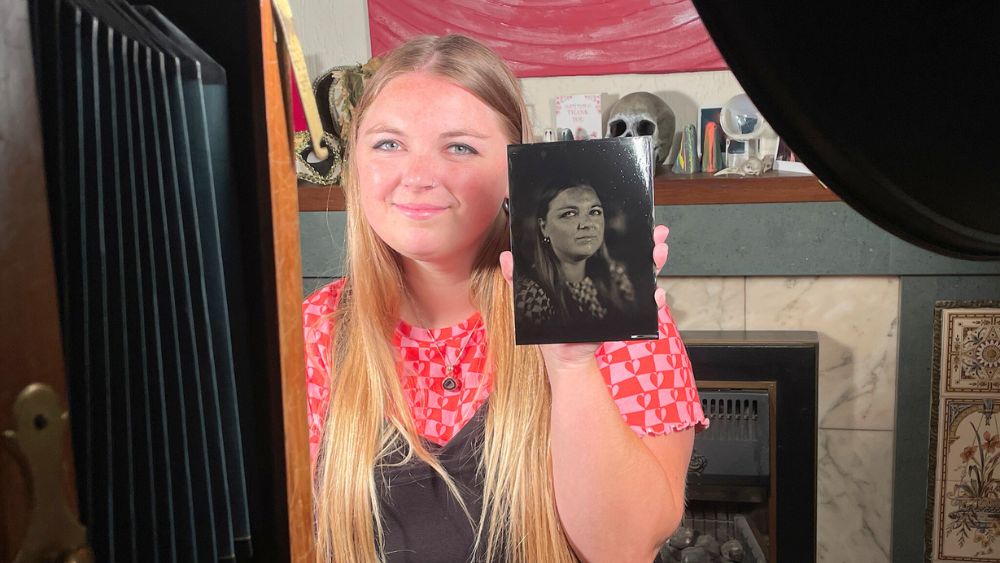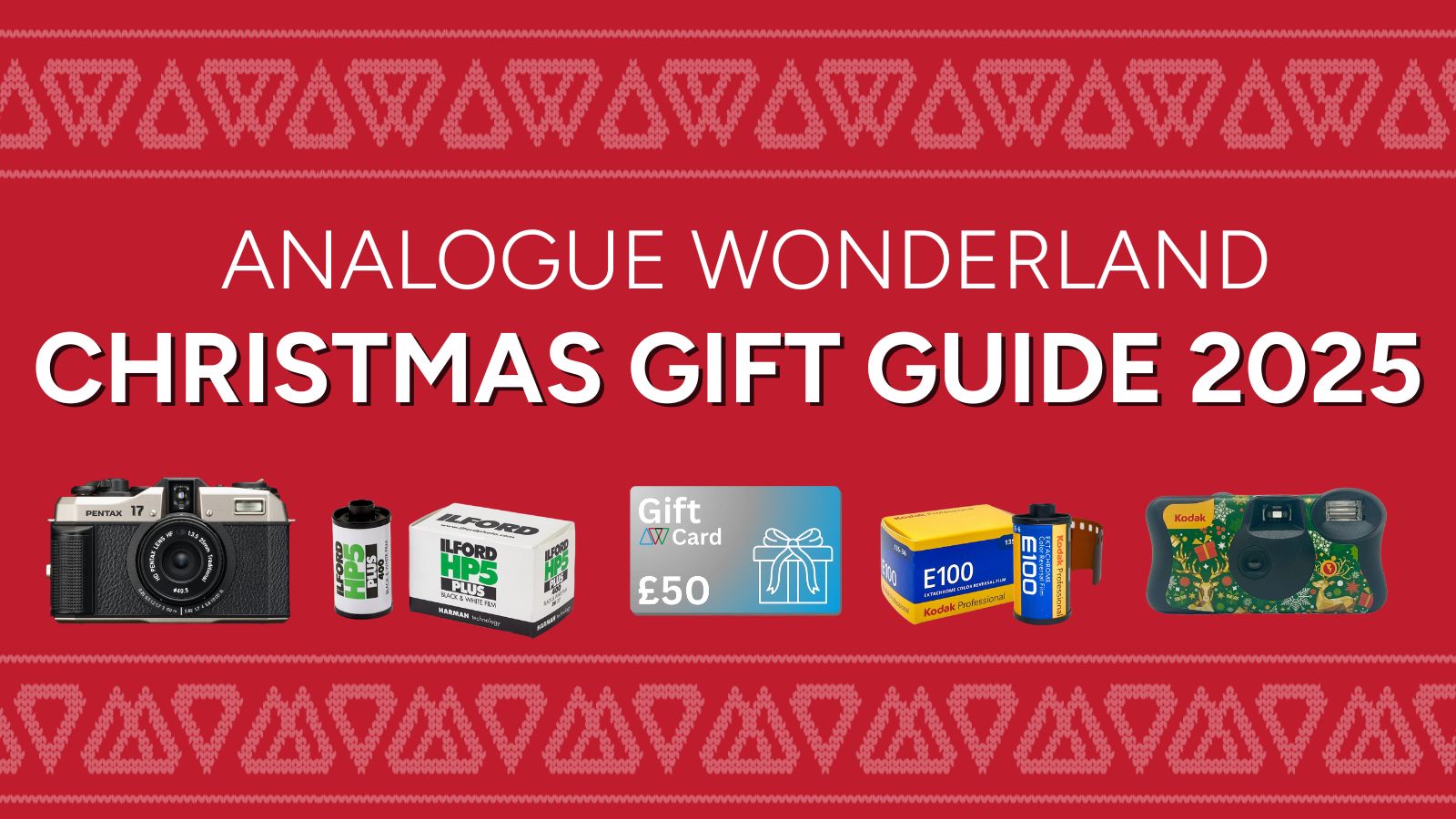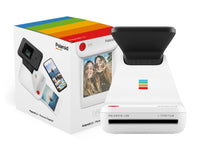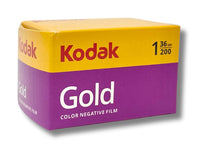Black Friday 2025 has landed at Analogue Wonderland, bringing some of our biggest film photography deals of the year - from discounted film and cameras to money-saving WonderLab processing offers, exclusive bundles, and festive specials available for a limited time only. Grab a great deal while stocks last!
Recent posts
Shop the article

A Step Back in Time: Wet Plate Portraits with Dark Art Sessions
By Amy Farrer
Analogue photography goes far beyond just shooting 35mm or 120 film, and our talented ambassador Corrine West demonstrates this perfectly! Referring to herself as a 'creative sorceress,' Corrine brings an experimental edge to analogue photography, exploring magical processes like wet plate collodion, emulsion lifts, Polaroid manipulation, and plant-based photography.
Paul and I were thrilled to be part of her ‘Legacy of Creatives’ project, where she’s set out to capture creative minds using the timeless 170-year-old wet plate collodion technique. Seeing our photos (literally) come to life in front of our eyes was simply magic ✨
The Origins of Wet Plate Collodion
You’ve probably seen those eerie Victorian portraits where no one seems to be smiling. Well, they’ve been subject to judgement all these years, since you quite literally can’t move the moment that shutter opens. Contrary to popular belief, it’s not because they had a lack of cheer! Capturing portraits on wet plate collodion requires real patience, with long exposure times as each metal plate has to be carefully added and removed by hand. Holding a smile for that long, with bright lights fixed on you? Practically impossible!
Introduced by Frederick Scott Archer in 1851, the wet plate collodion process combined elements of earlier Victorian photography methods: William Henry Fox Talbot’s calotype (first successful negative in 1835) and Louis Daguerre’s daguerreotype (publicly announced in 1839). The wet plate collodion process, more commercially viable than its predecessors, involves coating a glass plate with a solution of light-sensitive silver salts, which must be exposed while still wet.

Shared by James Morley on Flickr. A Victorian portrait developed using the wet plate collodion process - showing the negative (left) compared to the developed image (right).
Recognising the unique beauty of these portraits, Corrine - along with many other photographers - has embraced the wet plate collodion process as part of her analogue photography offering. There’s a fascination with the artistry of the past, and these Victorian photographic techniques prove that often the simplest processes can yield the most magical results. It’s worlds apart from today’s digital images!
If you love shooting film for its tactile feel, nostalgic charm, and mindful process, wet plate photography might be the next analogue experiment for you!
How to Create a Wet Plate Portrait
The wet plate collodion process has remained largely unchanged since Victorian times - though equipment and chemicals are thankfully much easier to source (thanks, internet!). Though it's a lot more hazardous than your usual lab development! If you’ve ever wondered how it’s done, here’s a simple, step-by-step guide from Corrine herself.
- Step 1: Wear a mask, gloves, and old clothes - chemicals like silver nitrate are toxic and stain everything black.
- Step 2: Pour collodion over the metal plate, covering it fully. Pour any excess chemicals back into the bottle and gently agitate for even drying.
- Step 3: Submerge the plate in silver nitrate (within complete darkness in the silver box) for 3 minutes to make it light-sensitive.
- Step 4: In red light, remove the plate, let the excess chemicals drip off, place it in the plate holder, and wipe the back.
- Step 5: Now, you have 10 minutes to shoot! Set up everything beforehand with the model or subject and check your focusing. Load the plate holder, lift the slider, take the exposure, then close the slider - the plate is ready for development.
- Step 6: Remove the plate, pour developer over it, and agitate to reveal the image. Rinse with tap water, then add it to the fixer to finalise the image.
- Step 7: If white spots appear, leave the plate in the fixer a bit longer and the image will come through.
- Step 8: Rinse in water for 15 minutes and let it dry. Voilà, you have a wet plate portrait!
We were thrilled to host Corrine in a recent Club AW Click & Chat session, where she shared a video on the wet plate collodion process and demonstrated emulsion lifts using Polaroids created with the Polaroid Lab. You can watch the full session below, or jump to 01:46 to go straight to the wet plate collodion demo!
The Moment We’d Been Waiting For… The Results!
I’d never had a wet plate portrait taken before, so I wasn’t sure what to expect - but I was very excited to see the results! My first reaction was, 'Wow, this is unlike any other photo I've had.' The silver nitrate truly brings out your features - in my case, my freckles made me look like a dusty mine worker 😂. Corrine also shared how wet plate photography makes tattoos disappear, so criminals back in the day would avoid disguise by appearing as distinguished gentlemen. So fascinating!
Here’s our favourite portraits from the day…

Holding my beloved Olympus OM10 🫶 I love the striking contrast in this, and my choice of t-shirt definitely paid off with those geometric patterns.

This was the first exposure of the day - and boy did it pack a punch! Paul dressed in his Victorian attire and certainly looked like he'd been transported straight from the 1800s.
And of course, we can't forget our Halloween-style portraits - they were absolutely hilarious to watch develop! Who knew we had such a dark side? True to the name 'Dark Art Sessions,' Corrine’s house is filled with all things macabre - skulls, ghosts, and plenty of cats. The opportunity was staring us right in the face (quite literally, with this skull 💀)!

Who would you rather encounter in a dark alleyway - Paul or Amy? 😂
Naturally, we documented the day across various media, including Paul’s go-to Pentax 17, capturing plenty of behind-the-scenes moments on Kodak Gold for you all to enjoy!
Learn From Dark Art Sessions
We had an incredible day with Corrine and were absolutely blown away by the magic she is able to create. There are so many creative avenues in analogue photography beyond traditional negatives. As a passionate teacher of experimental photographic processes, she offers a wealth of knowledge to anyone eager to learn. Whether through online courses or in-person workshops, Corrine is happy to share her expertise.
If you consider yourself a "creative" and want to be part of Corrine's Legacy of Creatives portrait project, get in touch with her! To learn more about Corrine West and her work at Dark Art Sessions, visit her website and follow her on social media to stay inspired.
Have you ever had your portrait taken using the wet plate collodion process? We'd love to hear about your experience in the comments below!
Ready to dive in?
Keep Reading
View all
Christmas 2025: Shipping & Opening Hours
Christmas 2025 is fast approaching! To make sure your analogue goodies arrive in time, take note of our last shipping dates, plus opening and operating hours over the festive season. We've got everything you need to gift the magic of film photography this Christmas!

Film Photography Christmas Gift Guide 2025: Analogue Wonderland
Capture the magic of Christmas with film - no filters needed. Our 2025 Film Photography Christmas Gift Guide 2025 is packed with thoughtful presents for every type of shooter, from curious beginners to seasoned photographers. Discover film stocks, cameras, and creative accessories that will make this festive season truly memorable.
Subscribe to our newsletter 💌
Sign up for our newsletter to stay up to date on film photography news, sales and events:
Free Tracked Shipping
On all UK orders over £50
Passion For Film
An unbeatable range and an on-site lab
Our Customers Trust Us
Thousands of independent 5* reviews
All Deliveries are Carbon Neutral
Independently audited and verified by Planet
- Opens in a new window.








2 Comments -
Alex • -
Stephen Spark •
Love the portraits. I’m going to take it as read that this is AW soft-announcing that it’s going to start selling wet plate supplies..?
Wet plate collodion? So cool! How long is the exposure BTW? The silver nitrate ‘stain everything black’ approach is perfect for goths and darkwavers. I have a pair of once-black trousers that have faded, so I definitely need to take this up. Maybe not suitable for a one-bed flat set-up though… hmmm.
And of course you both look fabulous!